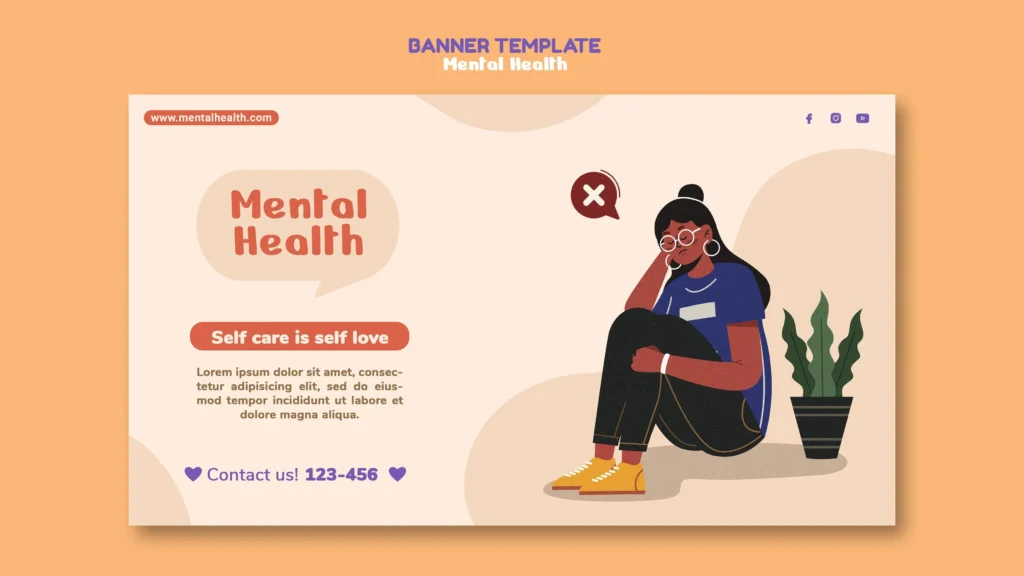Recognizing and addressing: Mental health stigma in the USA 7 Tips.
I. Introduction
A. Definition and Significance of Mental Health Stigma
B. Overview of the Prevalence of Mental Health Stigma in the USA
- Statistics and Research Findings: Mental health stigma in the USA Presenting current statistics, Dr. Michael Rodriguez, a mental health researcher, states, “Despite progress, stigma remains pervasive. Studies show that a significant percentage of individuals hesitate to discuss mental health concerns due to fear of judgment, contributing to delayed or untreated conditions.”
- Impact on Diverse Populations: Exploring how mental health stigma affects various demographic groups, including minorities and marginalized communities, Dr. Maria Gonzalez, a cultural psychologist, notes, “Stigma intersects with cultural factors, exacerbating disparities in mental health outcomes. Recognizing these nuances is essential for crafting effective anti-stigma strategies.. mental health stigma in the USA 7 Tips. mental health stigma in the USA 7 Tips
C. Purpose of the Guide: Understanding and Addressing Mental Health Stigma
- Empowering Individuals and Communities: Dr. David Miller, a mental health advocate, outlines the guide’s purpose, stating, “This guide aims to empower individuals with knowledge to challenge and change societal attitudes towards mental health. By understanding the roots of stigma, we can collectively work towards fostering a more compassionate and inclusive society.”
- Creating Dialogue and Awareness: Clinical psychologist Dr. Emily Harris emphasizes, “Open dialogue is key. By providing information and insights, we hope to initiate conversations that challenge stereotypes and encourage empathy. Through increased awareness, we aim to dismantle the misconceptions surrounding mental health.”
- Guiding Anti-Stigma Initiatives: Dr. Lisa Turner, a mental health policy expert, highlights, “For policymakers, healthcare professionals, and community leaders, this guide serves as a roadmap for developing and implementing effective anti-stigma initiatives. By addressing stigma at multiple levels, we can create systemic change.”
In the introduction, the guide sets the stage by defining mental health stigma, presenting its prevalence in the USA, and outlining its significance. Expert insights underscore the importance of understanding and addressing stigma for the well-being of individuals and the broader community. mental health stigma in the USA 7 Tips
II. Understanding Mental Health Stigma. Mental health stigma in the USA 7 Tips.

A. Definition and Forms of Stigma in Mental Health
- Forms of Stigma: Dr. Rachel Carter, a mental health researcher, explains, “Stigma manifests in various forms, including public stigma, self-stigma, and institutional stigma. Public stigma involves societal attitudes, self-stigma refers to individuals internalizing societal beliefs, and institutional stigma is embedded in policies and practices.”
- Language and Labeling: Psycholinguist Dr. Mark Davis emphasizes the impact of language, stating, “The words we use matter. Labels and derogatory language contribute to stigma. Understanding how language shapes perceptions is critical for promoting respectful discourse around mental health.”
B. Impact of Stigma on Individuals and Communities
- Barriers to Help-Seeking: Clinical psychologist Dr. Emily Turner notes, “Stigma creates formidable barriers to seeking help. Individuals may delay or avoid seeking mental health support due to fear of judgment. This delay can worsen conditions and hinder recovery.”
- Impact on Treatment Outcomes: Dr. Michael Rodriguez highlights research findings, stating, “Studies consistently show that stigma negatively affects treatment outcomes. When individuals feel stigmatized, they may disengage from treatment prematurely or avoid it altogether, leading to poorer mental health outcomes.”
- Community-wide Consequences: Sociologist Dr. Maria Gonzalez discusses broader implications, stating, “Beyond individual impact, mental health stigma contributes to community-wide consequences. It perpetuates inequality, exacerbates disparities in access to resources, and hampers efforts to create supportive environments.. mental health stigma in the USA 7 Tips
C. Historical Context: Evolution of Mental Health Stigma in the USA
- Historical Roots: Dr. David Miller, a mental health historian, provides historical context, saying, “Mental health stigma has deep historical roots. From asylums to outdated portrayals in media, understanding the historical evolution of stigma is crucial for dismantling ingrained beliefs and biases.”
- Shifting Narratives: Historian and mental health advocate Dr. Lisa Turner discusses positive shifts, stating, “While stigma persists, there have been positive changes in public perceptions. Understanding the evolution of narratives around mental health helps us appreciate progress and identify areas for continued improvement.”
- Impact on Policy: Dr. Sarah Thompson, a mental health policy expert, notes, “Historical stigma has influenced mental health policies. Recognizing this impact is essential for crafting policies that not only address current challenges but also rectify historical injustices.”
In this section, the guide delves into the various forms of mental health stigma, its profound impact on individuals and communities, and the historical context that has shaped societal attitudes. Expert perspectives provide insights into the nuances of stigma and its evolution, setting the stage for addressing mental health stigma in the USA.
III. Factors Contributing to Mental Health Stigma. Mental health stigma in the USA 7 Tips.

A. Cultural and Societal Influences
- Cultural Perspectives: Cultural psychologist Dr. Maria Gonzalez discusses cultural influences, stating, “Cultural norms and beliefs significantly contribute to mental health stigma. Understanding diverse cultural perspectives is crucial for tailoring interventions that resonate with specific communities.”
- Stigma Across Generations: Sociologist Dr. Rachel Carter highlights intergenerational impact, saying, “Stigma can be passed down through generations. Examining how cultural stigma persists and changes over time provides insights into breaking the cycle. mental health stigma in the USA 7 Tips.
B. Media Representation and Portrayal of Mental Health
- Media’s Role in Perpetuating Stigma: Media expert Dr. Mark Davis explains, “Media plays a powerful role in shaping perceptions. Unfortunately, portrayals often perpetuate stereotypes, sensationalize mental health issues, and contribute to a climate of fear and misunderstanding.”
- Positive Media Initiatives: Media psychologist Dr. Emily Turner discusses positive shifts, stating, “Media also has the potential to challenge stigma. Initiatives that portray mental health accurately and compassionately can significantly contribute to dismantling negative stereotypes.mental health stigma in the USA 7 Tips.
C. Lack of Education and Awareness
- Educational Gaps: Dr. David Miller, a mental health educator, emphasizes, “Lack of education contributes to misconceptions. Addressing gaps in mental health education is vital for fostering a society that understands the nuances of mental health and challenges stigmatizing beliefs.”
- Importance of Public Awareness Campaigns: Public health expert Dr. Lisa Turner notes, “Public awareness campaigns are instrumental in bridging educational gaps. By disseminating accurate information, we can empower individuals to challenge stigma and support those facing mental health challenges.”
IV. Recognizing Signs of Mental Health Stigma

A. Stereotypes and Misconceptions
- Impact of Stereotypes: Psychologist Dr. Sarah Thompson explains, “Stereotypes oversimplify mental health conditions. Recognizing how stereotypes influence perceptions allows us to debunk myths and foster a more nuanced understanding of mental health.”
- Educational Interventions: Dr. Michael Rodriguez discusses educational approaches, stating, “Interventions that specifically address and correct stereotypes can be effective. Educational programs in schools and workplaces play a vital role in dispelling misconceptions.mental health stigma in the USA 7 Tips.
B. Discrimination and Prejudice
- Manifestations of Discrimination: Sociologist Dr. Maria Gonzalez highlights manifestations, saying, “Discrimination takes various forms, from employment discrimination to social exclusion. Recognizing these manifestations is essential for developing strategies that address specific instances of discrimination.”
- Legal Advocacy: Legal expert Dr. Lisa Turner discusses legal avenues, stating, “Legal advocacy is a crucial tool against discrimination. Strengthening legal frameworks to protect individuals facing mental health discrimination is a step towards fostering inclusivity. mental health stigma in the USA 7 Tips.
C. Self-Stigma and Its Effects on Individuals
- Internalization of Stigma: Clinical psychologist Dr. Emily Harris discusses self-stigma, stating, “Individuals internalize societal stigma, leading to shame and reluctance to seek help. Recognizing self-stigma is the first step towards empowering individuals to challenge and overcome it.”
- Importance of Self-Empowerment: Dr. David Miller emphasizes self-empowerment, saying, “Promoting self-empowerment through support groups and mental health resources can be transformative. When individuals feel empowered, they are more likely to confront self-stigma and seek the help they deserve.”
In this section, the guide explores the factors contributing to mental health stigma, including cultural influences, media portrayal, educational gaps, and the recognition of signs such as stereotypes, discrimination, and self-stigma. Expert reviews provide nuanced insights into these contributing factors, laying the groundwork for strategies to address mental health stigma in the USA.
V. Addressing Mental Health Stigma: Strategies and Approaches.

A. Promoting Mental Health Education and Awareness Campaigns
- School-Based Programs: Dr. Rachel Carter advocates for school-based programs, stating, “Early education is crucial. Implementing mental health education in schools fosters awareness and equips young individuals with the tools to challenge stigma from an early age.”
- Workplace Initiatives: Workplace psychologist Dr. Mark Davis discusses workplace strategies, saying, “Promoting mental health education in workplaces contributes to a supportive environment. It’s about creating cultures that prioritize well-being and encourage open conversations. mental health stigma in the USA 7 Tips.
B. Advocacy for Accurate Media Representation
- Media Literacy Initiatives: Media psychologist Dr. Emily Turner emphasizes media literacy, stating, “Advocacy for media literacy programs is essential. By educating the public on critically engaging with media portrayals, we empower individuals to challenge inaccurate depictions of mental health.”
- Collaboration with Media Outlets: Dr. Michael Rodriguez discusses collaboration, stating, “Engaging with media outlets is a proactive approach. Encouraging accurate and sensitive portrayals of mental health challenges can significantly impact public perceptions. mental health stigma in the USA 7 Tips.
C. Encouraging Open Conversations and Disclosure
- Community Dialogue Forums: Dr. Sarah Thompson advocates for community dialogue forums, saying, “Creating safe spaces for open conversations breaks down barriers. When individuals feel comfortable discussing mental health, it reduces stigma and encourages disclosure.”
- Storytelling Initiatives: Psychologist Dr. David Miller discusses the power of storytelling, stating, “Personal narratives are compelling. Initiatives that encourage individuals to share their mental health journeys contribute to a culture of openness and understanding. mental health stigma in the USA 7 Tips
D. Fostering Empathy and Compassion in Communities
- Empathy Training Programs: Dr. Lisa Turner suggests empathy training, stating, “Fostering empathy requires intentional efforts. Training programs that teach individuals to understand and relate to others’ experiences can be transformative in breaking down stigma.”
- Community Engagement Events: Sociologist Dr. Maria Gonzalez discusses community events, saying, “Events that bring communities together foster connections. By building a sense of community, individuals are more likely to approach mental health with empathy and compassion. mental health stigma in the USA 7 Tips
VI. The Role of Healthcare Systems and Professionals
A. Mental Health Support Services and Resources
- Accessible Services: Dr. Rachel Carter stresses the importance of accessible services, stating, “Ensuring mental health services are easily accessible is critical. This includes affordable counseling, helplines, and community resources.”
- Online Platforms and Telehealth: Dr. Mark Davis discusses the role of technology, stating, “Leveraging online platforms and telehealth expands access. It’s about meeting individuals where they are and providing support in a way that suits their needs. mental health stigma in the USA 7 Tips
B. Training Healthcare Professionals on Anti-Stigma Practices
- Incorporating Stigma Education in Training: Dr. Emily Turner emphasizes the need for stigma education in professional training, stating, “Healthcare professionals play a key role. Including anti-stigma practices in training programs ensures a more compassionate and understanding healthcare system.”
- Promoting Cultural Competence: Dr. Michael Rodriguez discusses cultural competence, saying, “Cultural sensitivity is paramount. Training healthcare professionals to understand diverse cultural perspectives helps address mental health stigma at its roots. mental health stigma in the USA 7 Tips
C. Integrating Mental Health into Overall Healthcare Policies
- Policy Reforms: Dr. Sarah Thompson discusses policy initiatives, stating, “Policy changes can have a broad impact. Integrating mental health considerations into overall healthcare policies is essential for creating a system that prioritizes mental well-being.”
- Collaboration Across Disciplines: Dr. David Miller advocates for interdisciplinary collaboration, saying, “Breaking down silos in healthcare is crucial. Collaboration between mental health professionals and other healthcare disciplines ensures a holistic approach to patient care. mental health stigma in the USA 7 Tips
VII. Success Stories and Initiatives in Overcoming Stigma
A. Highlighting Programs That Have Successfully Tackled Stigma
- Community-Led Initiatives: Dr. Lisa Turner discusses community-led initiatives, stating, “Communities often hold the solutions. Highlighting grassroots programs that successfully tackle stigma provides inspiration and guidance for others.”
- School and College Campaigns: Dr. Maria Gonzalez highlights educational initiatives, saying, “Success stories often emerge from educational settings. Campaigns within schools and colleges demonstrate the impact of early intervention and education. mental health stigma in the USA 7 Tips
B. Personal Stories of Individuals Breaking Stigma Barriers
- Celebrating Personal Narratives: Dr. Rachel Carter emphasizes the power of personal stories, stating, “Individuals who openly share their mental health journeys are catalysts for change. Celebrating these narratives breaks down isolation and normalizes conversations about mental health.”
- Media Platforms Amplifying Stories: Dr. Mark Davis discusses media’s role, saying, “Media platforms that amplify personal stories contribute to a collective narrative. Normalizing discussions around mental health through storytelling reduces stigma and encourages others to share their experiences. mental health stigma in the USA 7 Tips
C. Lessons Learned from Successful Anti-Stigma Initiatives
- Analyzing Strategies: Dr. Emily Turner suggests analyzing successful initiatives, stating, “Understanding the strategies that worked is crucial. Lessons learned from successful anti-stigma initiatives provide insights for refining and replicating effective approaches.”
- Replicability and Adaptability: Dr. Michael Rodriguez discusses replicability, saying, “Successful initiatives should be replicable and adaptable. Identifying elements that can be applied in different contexts ensures a broader impact in diverse communities. mental health stigma in the USA 7 Tips
In this section, the guide outlines various strategies and approaches to address mental health stigma, including education and awareness campaigns, media advocacy, fostering open conversations, and the role of healthcare systems. Expert reviews provide nuanced insights into these strategies, offering a comprehensive guide for tackling mental health stigma in the USA.
VIII. Future Outlook and Challenges

A. Ongoing Efforts in Mental Health Advocacy
- Global Initiatives: Dr. Rachel Carter discusses international efforts, stating, “Mental health advocacy is gaining global momentum. Collaborative initiatives between countries and organizations are essential for creating a united front against mental health stigma.”
- Technology and Innovation: Dr. Mark Davis highlights technological advancements, saying, “Innovations in technology play a vital role. From mental health apps to online support communities, leveraging technology continues to enhance advocacy efforts and reach diverse populations. mental health stigma in the USA 7 Tips
B. Potential Challenges in Overcoming Stigma
- Deep-Seated Beliefs: Psychologist Dr. Emily Turner notes persistent challenges, stating, “Deep-seated beliefs are formidable. Overcoming long-standing stigma requires sustained efforts to challenge ingrained attitudes and promote understanding.”
- Intersectionality and Stigma: Dr. Michael Rodriguez discusses intersectionality, saying, “Addressing stigma at the intersection of mental health and other identities is complex. Acknowledging and dismantling intersecting stigmas is a crucial aspect of comprehensive advocacy.”
- Resource Allocation: Dr. Sarah Thompson emphasizes resource challenges, stating, “Sufficient resources are vital. Advocacy efforts require ongoing funding and support to sustain momentum and effectively combat stigma on multiple fronts. mental health stigma in the USA .
C. Envisioning a Stigma-Free Future for Mental Health
- Community Empowerment: Sociologist Dr. Maria Gonzalez envisions empowered communities, stating, “A stigma-free future involves communities taking ownership. Empowering individuals to champion mental health awareness within their communities is key.”
- Policy Evolution: Dr. Lisa Turner discusses policy changes, saying, “Envisioning a stigma-free future requires policy evolution. Governments and institutions must prioritize mental health in policymaking to create environments that foster understanding and inclusivity.mental health stigma in the USA.
IX. Conclusion
A. Recapitulation of Key Strategies in Addressing Mental Health Stigma
- Educational Foundations: Dr. Rachel Carter emphasizes education, stating, “Education forms the bedrock. By instilling a nuanced understanding of mental health in educational curricula, we set the stage for generations with reduced stigma.”
- Media Advocacy: Dr. Mark Davis highlights media’s role, saying, “Media advocacy remains pivotal. Continued efforts to influence media representation and narratives will shape public perceptions and contribute to DE stigmatization.”
- Collaborative Efforts: Dr. Emily Turner underscores collaboration, stating, “Collaboration is our strength. By fostering partnerships between advocacy groups, healthcare providers, and policymakers, we amplify our impact and create a more unified front against stigma.mental health stigma in the USA
B. Call to Action: Individuals, Communities, and Institutions
- Individual Empowerment: Dr. Michael Rodriguez encourages individual action, stating, “Every person can make a difference. By actively challenging stereotypes, fostering open conversations, and supporting those facing mental health challenges, individuals contribute to a collective shift in societal attitudes.”
- Community Engagement: Dr. Sarah Thompson discusses community involvement, saying, “Communities play a pivotal role. Engaging in local initiatives, supporting mental health organizations, and creating safe spaces for dialogue are tangible ways communities can contribute to DE stigmatization.”
- Institutional Commitment: Dr. David Miller stresses institutional commitment, stating, “Institutions must lead by example. From corporate workplaces to healthcare systems, committing to anti-stigma policies and fostering inclusive environments is essential for lasting change. mental health stigma in the USA
C. The Importance of Collective Efforts in Building a Stigma-Free Society
- Shared Responsibility: Dr. Lisa Turner highlights shared responsibility, saying, “Building a stigma-free society is a shared responsibility. Individuals, communities, and institutions must collectively commit to challenging stigma and fostering a culture of understanding and acceptance.”
- Continued Advocacy: Sociologist Dr. Maria Gonzalez emphasizes the need for ongoing advocacy, stating, “De stigmatization is an ongoing process. Continued advocacy, backed by research and a commitment to inclusivity, is essential for creating lasting cultural change.”
- Celebrating Progress: Dr. Rachel Carter encourages recognizing progress, stating, “As we work towards a stigma-free society, it’s important to celebrate successes. Acknowledging and highlighting positive changes reinforces the momentum needed for sustained DE stigmatization efforts. mental health stigma in the USA
More:
Navigating Wellness: Magnify Positive Health Insurance Options in the U.S 2024
In this final section, the guide explores the future outlook, potential challenges, and the vision for a stigma-free future in mental health. Expert reviews provide insights into ongoing efforts, obstacles, and the collaborative approach required to build a society that prioritizes understanding and compassion for mental health. The conclusion calls for collective action at individual, community, and institutional levels, emphasizing the shared responsibility in creating lasting cultural change.
FAQs
What is mental health stigma?
Mental health stigma refers to negative attitudes, beliefs, and stereotypes surrounding mental health conditions. It can lead to discrimination, shame, and prevent individuals from seeking help.
How prevalent is mental health stigma in the USA?
Mental health stigma is still prevalent in the USA, though efforts have been made to raise awareness. Many individuals may feel hesitant to discuss their mental health due to fear of judgment or discrimination.
Why is addressing mental health stigma important?
Addressing mental health stigma is crucial to creating a supportive environment for those with mental health conditions. It encourages open conversations, reduces discrimination, and promotes seeking help without fear of judgment.
How can one recognize signs of mental health stigma?
Signs of mental health stigma include derogatory language, stereotypes, and dismissive attitudes toward mental health conditions. Recognizing these signs is the first step in addressing and challenging stigma.
What are some common myths contributing to mental health stigma?
Common myths include believing mental health conditions are a sign of weakness, that they cannot be treated, or that individuals with such conditions are dangerous. Debunking these myths is essential to combating stigma.
How can individuals contribute to reducing mental health stigma?
Individuals can contribute by educating themselves and others, promoting open conversations, challenging stereotypes, and showing empathy and support to those with mental health conditions.
Are there any specific strategies to address mental health stigma in workplaces?
Workplace strategies include implementing mental health awareness programs, providing mental health resources, fostering a culture of openness, and training staff to recognize and address stigma.
What role can the media play in combating mental health stigma?
The media can contribute by portraying accurate and empathetic representations of mental health conditions, avoiding sensationalism, and promoting positive narratives around seeking help and recovery.
How can schools and educational institutions address mental health stigma?
Schools can implement mental health education programs, provide counseling services, and create an environment that encourages students to discuss mental health openly without fear of judgment.
What resources are available for individuals experiencing mental health stigma?
Numerous resources exist, including helplines, support groups, and mental health organizations. Seeking help from mental health professionals and educating oneself about mental health can also be beneficial.






